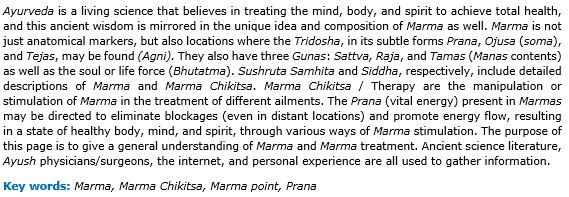A conceptual study on Marma and its practical application in Chikitsa
Keywords:
Marma, Marma Chikitsa, Marma point, PranaAbstract
Ayurveda is a living science that believes in treating the mind, body, and spirit to achieve total health, and this ancient wisdom is mirrored in the unique idea and composition of Marma as well. Marma is not just anatomical markers, but also locations where the Tridosha, in its subtle forms Prana, Ojusa (soma), and Tejas, may be found (Agni). They also have three Gunas: Sattva, Raja, and Tamas (Manas contents) as well as the soul or life force (Bhutatma). Sushruta Samhita and Siddha, respectively, include detailed descriptions of Marma and Marma Chikitsa. Marma Chikitsa / Therapy are the manipulation or stimulation of Marma in the treatment of different ailments. The Prana (vital energy) present in Marmas may be directed to eliminate blockages (even in distant locations) and promote energy flow, resulting in a state of healthy body, mind, and spirit, through various ways of Marma stimulation. The purpose of this page is to give a general understanding of Marma and Marma treatment. Ancient science literature, Ayush physicians/surgeons, the internet, and personal experience are all used to gather information.
Downloads
References
Sharma SP. Shareera Sthana chapter 7 verse 24 Astanga Sangraha with Sashilekha Sanskrit commentary of Indu. 2nd ed. Varanasi (India): Chaukambha Orientalia; 2008; p.326.
Sushruta Samhita Dalhana Acharya Virachita Nibhandhasangraha vyakhya, Vaidya Yadavaji Trikamaji Acharya, Choukhambha Surabharati Prakashana, Varanasi, reprint 2010. Page no: 369.
Acharya YT. Shareera Sthana chapter 6 verse 26 Sushruta Samhita with Nibhandhasangraha commentary of Dalhanacharya. Reprint ed. Varanasi (India): Chaukambha Sankrit Sansthan; 2010.;p.55.
Bhaskar Govind Ghamekar, Sushruta Samhita, Ayurveda sandipika, Hindi, vyakhya, 3rd edition 1997, Meherechandre Lakashamendas (Sanskrit) 6/44.
Bhaskar Govind Ghamekar, Sushruta Samhita, Ayurveda sandipika, Hindi, vyakhya,3rd edition 1997, Meherechandre Lakashamendas (Sanskrit) 6/14.
Bhaskar Govind Ghamekar, Sushruta Samhita, Ayurveda sandipika, Hindi, vyakhya,3rd edition 1997, Meherechandre Lakashamendas (Sanskrit) 6/24.
Sushruta Samhita with Hindi commentary by Kaviraj Ambikadutta Shastri, Part-1, page no. 67,Sharir Sathan 6/4, by Chaukhambha Sanskrit Sansthan, 2011.
Sushruta Samhita with Hindi commentary by Kaviraj Ambikadutta Shastri, Part-1, page no. 67,Sharir Sathan 6/5, by Chaukhambha Sanskrit Sansthan, 2011.
Sushruta Samhita with Hindi commentary by Kaviraj Ambikadutta Shastri, Part-1, page no. 67, Sharir Sathan 6/8, by Chaukhambha Sanskrit Sansthan, 2011.
Caraka Samhita of Agnivesha revised by Caraka and Drdhabala with an introduction by Vaidya samrata Sri Satyanarayana Sastri, Chikitsa sthana part 2 published by choukamba Bharati Academy, Varabasi reprint:2001, pg no:716 pp:1208.
Caraka Samhita of Agnivesha revised by Charaka and drdhabala with an introduction by Vaidya samrata Sri Satyanarayana Sastri, Siddhi sthana part 2 published by choukamba Bharati Academy, Varabasi reprint:2001, pg no:1050 pp:1208.
Negi Vineeta Kumari, Marma, and Marma Therapy: A Review, Research Officer Regional Ayurveda Research Institute for Nutritional Disorders, CCRAS, Ministry of Ayush, Jaral Pandoh Mandi, World Journal of Pharmaceutical Research Volume 7, Issue 15, 258-271. 15
Mamatha TS, Shankar S. Swamy, S. V. Shailaja. Understanding the concept of Marma and their clinical application in Shalya Tantra w.s.r. to Vital points. J Ayurveda Integr Med Sci 2018;5:89-92.
Negi Vineeta Kumari, Marma, and Marma Therapy: A Review, Research Officer Regional Ayurveda Research Institute for Nutritional Disorders, CCRAS, Ministry of Ayush, Jaral Pandoh Mandi, World Journal of Pharmaceutical Research Volume 7, Issue 15, 258-271.















